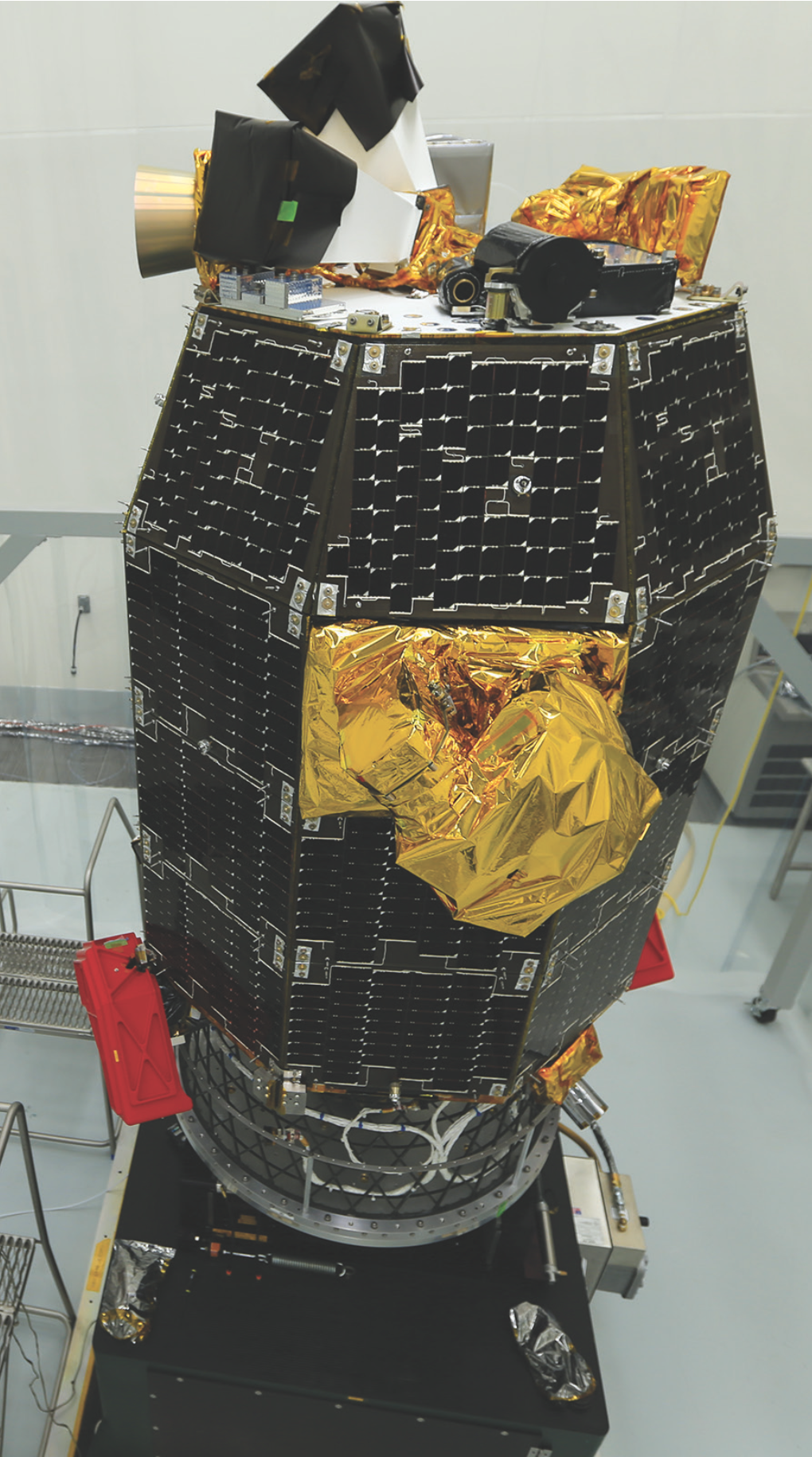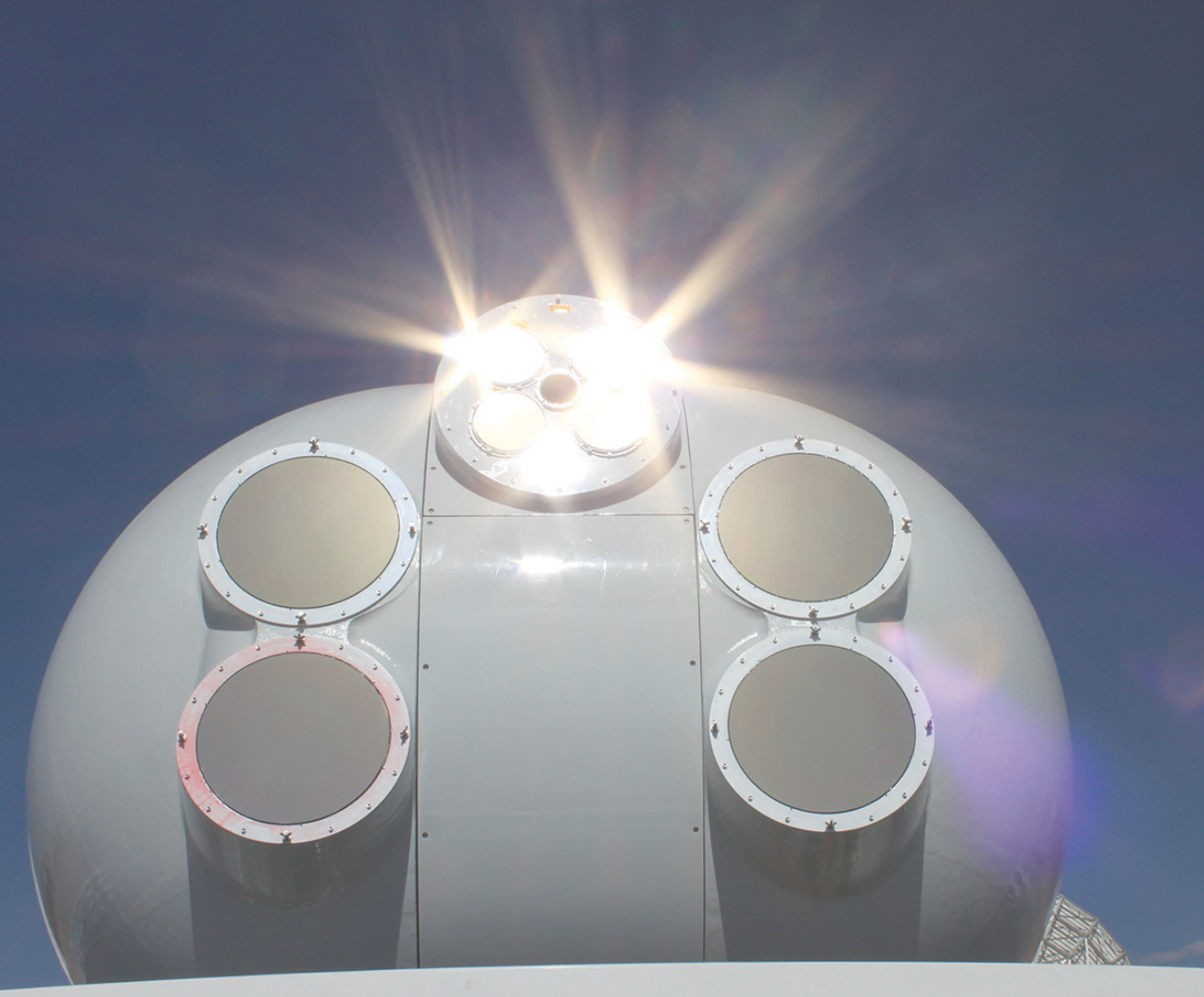Tech notes
Lunar Laser Communication System
A laser communication system that achieves record-high data transmittal rates could expand what's possible for future science missions to the Moon and beyond.
 The Lunar Laser Communication System's space terminal is seen above during integration on NASA's Lunar Atmosphere and Dust Environment Explorer spacecraft.
The Lunar Laser Communication System's space terminal is seen above during integration on NASA's Lunar Atmosphere and Dust Environment Explorer spacecraft.For more than 30 years, the National Aeronautics and Space Administration (NASA) has been pursuing the development of technologies that could greatly increase the amount of data returned from its deep-space science probes. The distances involved are up to thousands of times greater than those of traditional geosynchronous satellite-to-ground links. Optical communications, with its use of very narrow beams and extremely wide electromagnetic spectrum, has long been considered a promising solution to NASA's deep-space communication needs and is no longer an elusive option.
On 17 October 2013, the Lunar Laser Communication System (LLCS) designed and built by MIT Lincoln Laboratory used a pulsed laser beam to transmit data over the 239,000 miles from the Moon to Earth at a record-breaking download speed of 622 megabits per second (Mbps). The LLCS also achieved an uplink rate to the moon 5000 times that of radio technology. The LLCS, flown aboard NASA's Lunar Atmosphere and Dust Environment Explorer (LADEE) spacecraft, demonstrated not only the longest laser communication (lasercom) link ever created but also the most reliable lasercom link to ever bring data down through the atmosphere, all accomplished with a space terminal that has half the weight of and uses 25% less power than the most capable lunar radio systems.
System Description
The LLCS consists of a space and a ground terminal. During the October demonstration, the space unit rode on the LADEE spacecraft and the relocatable ground terminal was stationed in White Sands, New Mexico. The LLCS uses invisible, eye-safe infrared lasers to send digital data—images, video, sensor outputs, and command-and control information—up and down through free space.
 The LLCS's ground terminal was deployed at White Sands, N.M., for the October-November 2013 month-long demonstration of the high-data-rate transmission from a lunar-orbiting satellite. The array of transmit apertures is located above the array of receive apertures.
The LLCS's ground terminal was deployed at White Sands, N.M., for the October-November 2013 month-long demonstration of the high-data-rate transmission from a lunar-orbiting satellite. The array of transmit apertures is located above the array of receive apertures.The space terminal comprises an optical module, modem, and controller electronics:
- The optical module's telescope is mounted on a two-axis gimbal that permits optical link operation over a wide range of spacecraft orientations. A wide-field-of-view indium gallium arsenide (InGaAs) quadrant detector enables fast spatial acquisition and coarse tracking of the optical uplink. Transmit and receive signals are coupled to and from the telescope via single-mode optical fibers, the tips of which are mounted to piezoelectric actuators that provide fine pointing capability.
- The modem contains a 0.5-watt infrared laser transmitter, high-speed electronics, and the sensitive receiver that measures the light pulses of data sent from the ground telescopes.
- The controller electronics module controls and monitors the health of the optical module and modem, manages the pointing of the optical module telescope, and provides the command and low-rate telemetry interfaces to the spacecraft carrying the terminal.
The space terminal's small size andweight, plus low power requirement, byproducts of the higher-frequency carrier used for the communication link, are distinct advantages. The system can be integrated on even lightweight spacecraft, as demonstrated on the LADEE mission, and because of the terminal's modular design, the mass of the terminal can be distributed, easing balancing requirements on the spacecraft.
The ground terminal is an array of transceiver and receiver telescopes plus a control facility. Arrays of telescopes are a scalable, cost-effective approach for providing large-aperture receivers and atmospheric-turbulence-mitigating transmitters that will be required for future NASA missions further out than the Moon.
 The optical module is a 10 cm Cassegrain telescope. Its solar rejection window allows the terminal to safely point at and next to the sun.
The optical module is a 10 cm Cassegrain telescope. Its solar rejection window allows the terminal to safely point at and next to the sun.Technology Innovations
The LLCS exploits innovative technologies to provide high-data-rate lasercom transmission over huge distances through Earth's atmosphere. The combination of advanced photon-counting receivers, pulsed transmitters, error-correction codes with their optimum decoders, channel data interleaving, and synchronization headers results in the most photon-efficient freespace lasercom system ever built. In addition, this system delivers, for the first time, reliable error-free performance through the turbulent atmosphere. The LLCS development led to advances in a number of areas:
- The space terminal employs a novel approach to stabilize the incoming and outgoing beams: the telescope and its back-end optics are inertially stabilized by using a magneto-hydrodynamic angular rate sensor that gives an inertial reference for rejecting high-frequency disturbances from the spacecraft.
- To minimize the effects of atmospheric turbulence on the uplink, the ground transmitter utilizes an array of four 15-centimeter telescopes, each with its own point-acquire-track system and steering mirrors and each fed from an independent 10-watt transmitter.
- The LLCS pioneers the inclusion, in both the uplink and downlink, of a powerful error-correction code paired with a long (up to one second) data interleaver, which acts to average the turbulence-induced signal fading. This construct allows reliable error-free communications even during stressing atmospheric turbulence.
- The downlink receiver is based on revolutionary superconducting nanowire single-photon detector technology developed jointly at Lincoln Laboratory and MIT. Arrays of superconducting nanowire single-photon-detectors (which distinguish and time-tag each separate photon in the downlink beam with accuracy better than 50 picoseconds [10–12 s] and efficiency better than 75%), when paired with the aforementioned error-correction code, enable a power efficiency 10 times better than that of any other system and the reception of wideband downlink signals. Multielement arrays of these detectors achieve the count rates necessary to support the 622 Mbps downlink. Each array is sized to simply and efficiently couple to the multimode fiber from its telescope.
Impact
The LLCS's ability to rapidly and reliably transmit enormous amounts of information will significantly transform the objectives, design, and operation of future scientific space missions, vastly increasing their scientific value. NASA is already using some of the LLCS designs, such as the space telescope and the pointing module, in the system for its upcoming long-duration Laser Communications Relay Demonstration, which is designed to help advance lasercom capabilities for future deep-space science and exploration missions. With the addition of a higher power space transmitter and somewhat larger ground telescope, the LLCS space terminal design could also be used to support high-rate transmissions over distances somewhat beyond the Moon.
Posted October 2014
top of page